GL Processor
Overview

Welcome to the GL Processor online documentation and reference site!
Compatible Financial Systems
The GL Processor is compatible with the following financial systems:
None / Passthrough Processing
Settings and Interface
Application Settings
This screenshot shows the GL Processor's main interface:
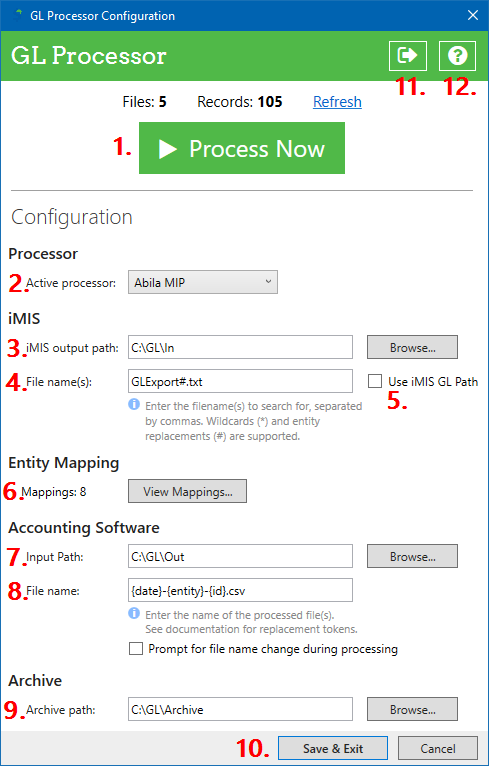
Process Now - Shows the number of detected files and records in the iMIS Output Path folder. Clicking Refresh will re-scan the folder and update the counts. Clicking Process Now will begin the file processing routine.
Active Processor - Changes the resulting file format. Currently supported file types are:
Intuit QuickBooks
Abila MIP
AccuFund
Blackbaud Financial Edge (Coming Soon)
iMIS Output Path - Set this to the same location that the iMIS desktop is set to drop files after the "Create G/L Journal" process.
File Name(s) - A wildcard file pattern to search for when looking for files to process. Only matching files will be processed by the GL Processor.
Use a
*character as a wildcard (e.g.GL*.txt)Use the
#character for entity-supported processing - this should match the filename that is set in iMIS (e.g.GL_Export_#.csv)
Use iMIS GL Path - Check this checkbox to retrieve and use the same filename as your iMIS A/R settings (Recommended!)
Entity Mappings - Only supported on certain types of processors. Click the "View Mappings..." button to open the Entity Mapping preview window (see below).
Input Path - Set this to the "drop folder" where you would like to store the resulting files after they are processed by the GL Processor.
File Name - Enter a file name pattern that will be used to determine the resulting file name. Special tokens are available, and encouraged to be used:
{file}- The original filename, excluding the extension.{date}- The current date, inYYYYMMDDformat.{entity}- Only for use with Entity-supported processors. This token is replaced with the defined entity group name in the entity mapping.{id}- If two output files will have the same name, use this as an incrementing unique index to distinguish them.
Archive Path - Specify a folder where the original (untouched) iMIS files are copied.
During copying, the files are prefixed with
_PROCESSED_YYYY-MM-DD__.
Save & Exit / Cancel - Press this button to save your configuration changes. Press Cancel to revert changes.
Logout Button - Click the Logout button to be signed out of iMIS and "forget" the stored connection to the iMIS database. When you start the GL Processor the next time, you will be prompted to sign in using the standard CSI iMIS login dialog box again. Use this method to switch between Live and Test instances, for example.
Help Menu - Use this menu to view information about the product and get support. This menu also contains some helpful iMIS utilities (see below).
Entity Mapping
This screenshot shows the entity mapping preview dialog:
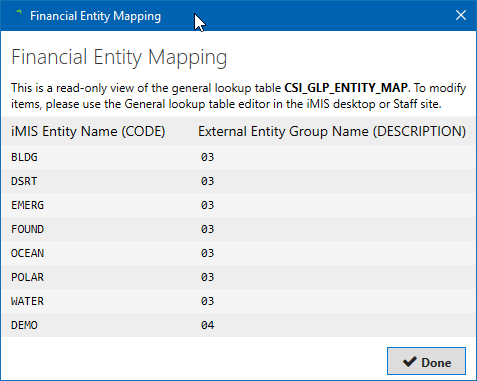
Mappings are edited via the CSI_GLP_ENTITY_MAP general lookup table in iMIS.
Code: The iMIS entity code name
Description: An arbitrary external group name to group each entity by (see below)
Note: Expansion is not used.
Entity mappings allow you to take multiple iMIS entities / org codes, and group them into one or more output files. For example, you might combine the WATER, MARSH, and OCEAN entities into an ENVIRONMENT group.
Group names are arbitrary - you are free to define as many or as few groups as you need. The system will combine entries if the group name in the right column is the same.
This diagram shows the relationship between the iMIS output files, and how the GL Processor can combine these files into groups that you define.
Compatibility
Note that the following export types require entity mappings:
Abila MIP
AccuFund
Dynamics GP
The following export types currently do not support entity mappings:
Intuit QuickBooks
Financial Edge
"None" Processor
Using QuickBooks Class Codes
If you are using the GL Processor in QuickBooks mode, and your account numbers have hyphens in them, the GL Processor will automatically convert them into separate QuickBooks class codes.
The following table demonstrates how the GL Processor will convert your account number with hyphens in it into a QuickBooks class code and account number.
iMIS Account Number | QuickBooks Account # | QuickBooks Class Code |
|---|---|---|
3000 | 3000 | |
1000-100 | 1000 | 100 |
50-1200 | 50 | 1200 |
75-100-5800 | 75 | 100-5800 |
iMIS Configuration
There is a utility window to assist with viewing and fixing the iMIS G/L configuration if it does not contain the correct settings for the GL Processor.
You can open this window by clicking the Help icon and selecting Advanced > View or fix iMIS configuration...
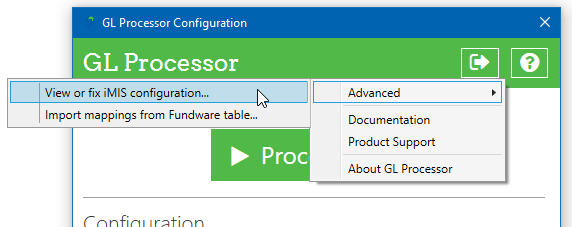
Configuration Window
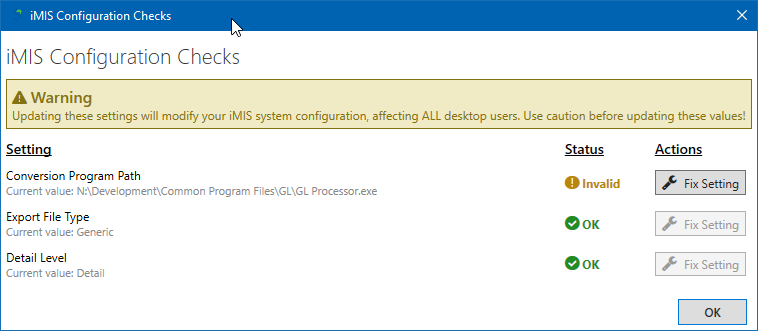
The following checks are performed on this window:
Conversion Program Path - This must be the full path to where the GL Processor is located.
Pressing Fix Setting on this entry will set the Conversion Program File Path/Name to the full path of where the GL Processor is currently running.
Export File Type - The GL Processor expects a file type of Generic or Generic 2000.
Pressing Fix Setting on this entry will set the GL interface type setting to Generic.
Detail Level - The GL Processor expects the summarize option to be set to Detail.
Pressing Fix Setting on this entry will set the Summarize by setting to Detail.
These settings correspond to the following settings in iMIS Desktop:

The GL Processor does not modify any other iMIS system settings besides the three highlighted in the screenshot above.
Using the GL Processor
The GL Processor is primarily designed to be invoked directly from the iMIS desktop as part of the "Create G/L Journal" process.
Application Logic and Flow
The following diagram outlines the overall process flow of the GL Processor app:
Running Manually
You can run the GL Processor manually as a one-off. To do this, simply launch the GL Processor from Windows, and when the configuration window opens, click the " Run Manual Process" button in the lower-left corner of the screen.
Running manually is the only supported way to process files when using Standalone Mode.
Running from the iMIS Desktop
If you have configured the GL Processor as your "Conversion Program" in the iMIS A/R Cash module, and the input/output file paths are set correctly, then the GL Processor should be invoked automatically as part of the Month-End process in iMIS.
After running the "Create GL Journal" process in iMIS and selecting a valid date range, the following prompt will appear:

This is the last step in the iMIS process, and when you click Yes, the GL Processor is started automatically.
If the GL Processor starts and correctly detects some files it needs to process from iMIS, you will see this prompt:

Click Process Now to process the files that were just exported from iMIS.
After processing, the following prompt will appear:
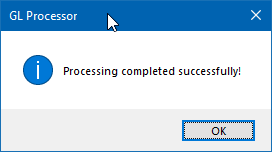
This indicates that the output files were written successfully, and the original iMIS files were moved into the Archive folder.
Deferring Processing
Click Defer Processing on the GL Processor prompt to cancel file processing. The original iMIS files will be left untouched in the iMIS export folder.
Use deferred processing when you need to manually modify or review the files before the GL Processor processes them.
Deferred processing is not recommended for normal day-to-day operations. It should only be used in special cases where manual intervention is required.
Running in Standalone Mode
Overview
The GL Processor can be run with two different modes. iMIS Mode, which is the default, contains additional features and iMIS integrations to make certain tasks easier in the GL Processor. Standalone modeisolates the GL Processor from iMIS, allowing it to run in an environment where iMIS may not be available, such as on an isolated VM.
You should only run the GL Processor in Standalone mode if the GL Processor installation location/environment is not able to support an iMIS login, or you were otherwise instructed to do so by CSI or your system administrator.
Launching in Standalone Mode
To launch the GL Processor in Standalone mode, navigate to Start > Programs > CSI Programs. You should see two shortcuts for GL Processor. One will be labeled GL Processor (Standalone). Select this shortcut.
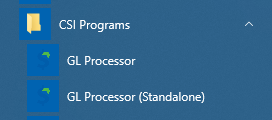
You can identify that the GL Processor is running in Standalone mode if the green application bar says Standalone Mode.
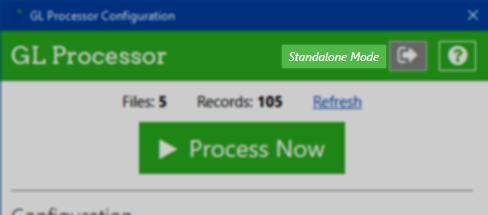
Differences
In Standalone mode, the GL Processor does not log into or connect to the iMIS database in any way.
The following features are unavailable in Standalone mode:
iMIS Log In / Log Out
Viewing / Fixing iMIS GL Configuration
Importing Fundware Mappings
Certain file types (financial systems) cannot be processed in Standalone mode because they require iMIS configuration data (see below), including:
Abila MIP
AccuFund
Dynamics GP
Automatically selecting the iMIS GL Path
Automatically processing files with the GL Processor when the Create G/L Journal process is run in iMIS
The following screenshot demonstrates that some of the active processors are disabled/not available in Standalone mode.
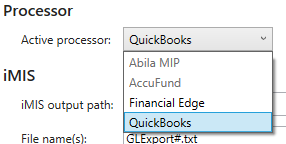
To process GL files in Standalone mode, open the GL Processor program manually. At the top, you will see the file and record count that was loaded by the GL Processor and is ready to be processed.
Press the Process Now button to begin processing these files.

Release Notes
Version | Date | Notes |
|---|---|---|
1.1.338 | 3/5/2015 |
|
1.0.280 | 9/2/2014 | Initial release of GL Processor |
